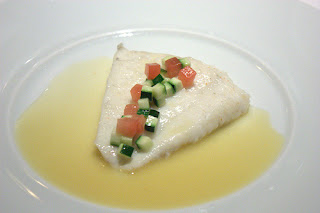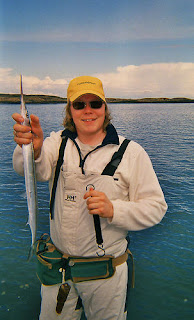from
Behind the French Menu
by
Bryan G. Newman
behindthefrenchmenu@gmail.com
A Wild Turbot
Turbot – Turbot or Breet, a flatfish, but not a flounder. Turbot is one of the world's best tasting white fish; it’s up there with Dover Sole. Turbot has lean, white, mild tasting, firm flesh and most of the fish on restaurant menus are farm-raised. If I had been asked to blind taste farm-raised turbot and wild turbot I would catch the farm-raised fish every time; nevertheless, farm-raised turbot is a whole lot better than no turbot.
Farm-raised turbot and wild turbot compared.
Farm-raised turbot weighs from 0.5 kg to 2 kg (1 to 4 lbs ). Wild turbot, turbot sauvage in French, are much larger than farmed fish. With their rounded diamond shape, wild turbot mostly weighs over 6 kg (13 lbs), and are sometimes larger. Wild turbot are caught off France’s Atlantic, and Mediterranean coasts and individual fish have been caught weighing over 10 kg (22 lbs). Turbot have been overfished, and catches are now limited.
Turbot is best when cooked as part of the whole fish, but then they may be very large, and so filets will be cut and prepared individually. Turbot filets are best when steamed, poached or pan-fried; regardless, turbot are on menus when grilled or roasted. As turbot is a fish that quickly dries out, grilling and roasting must be done with great care.
The French word for turbot is spelled the same as in English, but the final T is not pronounced. Just pronounce the word turbo, like a car with a turbo engine, and your server will be impressed.
Turbot and barbue - brill.
Restaurants have been known to use the smaller but similar tasting barbue, brill, when wild turbot is unavailable, and I have also seen a Parisian fish shop that was very openly selling brill marked as turbot. Nevertheless, there is not a huge difference in the taste as brill is a member of the turbot family. When brill is cooked its milder than turbot flavor may be hidden with a sauce, and so it is not easily identified. Before either of the fish are cooked or fileted it is easy to see that turbot is not a smooth fish and has bumps but no scales, while brill is smooth with scales.
Turbotin – A small turbot.
Turbot on French menus:
Filet de Turbot à la Crème d'Huîtres, Risotto aux Algues – Filet of turbot served with a creamy, oyster sauce and a seaweed-flavored risotto.
Lightly fried turbot
https://www.flickr.com/photos/djjewelz/5037597818/
Tronçon de Turbot Sauce Hollandaise - A filet of turbot served with Sauce Hollandaise. This cut, tronçon, is pronounced tronson. The cut is the original name used for filets from flatfish. Despite its origins tronçon is now used for a cut of meat also.
Pavé de Turbot. A wide filet of turbot. Literally, pavé means a paving stone or a flat slab. On a menu pavé will describe slices of steak, liver and or fish and is also used in the names of particular square and oblong-shaped cheeses.
Jean Georges Turbot with Chateau Chalon sauce.
Château-Chalon AOP is a vin jaune, a yellow wine, from the Jura wine region of France.
Vin Jaunes are aged for a minimum of six years and three months and taste like dry fino sherry.
Turbot Poché Sauce Hollandaise, Pommes Vapeur, Épinard (Pour Deux Personnes) – Poached turbot served in a Sauce Hollandaise together with steamed potatoes and spinach. (For two persons). Restaurants will prefer to cook their turbot, when purchased as a whole fish, on the bone, which is the tastiest way. A turbot provides four filets, and so here it seems they will be serving each diner two small filets, half of a small, farm-raised fish.
Turbot Rôti, Cocos de Paimpol, Jus de Crustacés – Roast turbot flavored with the cooking juices from crustaceans and accompanied by France’s AOC/AOP unique Cocos de Paimpol beans. N.B. On French menus, crustaceans include crabe – crabs; crevettes-shrimp; écrivisse – freshwater crayfish; homard- the two-clawed lobster; langouste – lobster tails; langoustine – Dublin Bay prawns or scampi, and more.
Lightly roasted turbot
served with fennel and samphire.
Samphire is a plant that grows wild along the coasts; it is not a seaweed though it is sometimes called sea asparagus, a name that is given for its looks, not its taste. The turbot steak in the picture was cooked with the skin on as turbot easily dries out when roasted.
Turbot Sauvage - Wild Turbot
The French word sauvage came to English as savage.
Turbot Sauvage (selon arrivage) Poché dans son Jus, Champignons, Petits Pois, Carottes, Crémeux Acidulée - Wild turbot, (depending on availability), poached in its own juices and served with a creamy, tangy sauce; accompanied by button mushrooms, baby peas, and carrots.
Turbot in the languages of France’s neighbors:
(Catalan - rèmol empetxinat), (Dutch – tarbot), (German – steinbutt), (Italian – rombo, rombo chiodato), (Spanish - rodaballo).
Connected Posts:
Sole Française. Dover Sole or Sole Française on French Menus. Dover Sole in France may be on your menu as Sole Française.
Behind the French Menu’s links include hundreds of words, names, and phrases that are seen on French menus. There are over 400 articles that include over 2,500 French dishes with English translations and explanations. Just add the word, words or phrase that you are searching for to the words "Behind the French Menu" and search with Google or Bing.
Behind the French Menu
by
Bryan G. Newman
behindthefrenchmenu@gmail.com
Copyright 2010, 2016, 2017.








